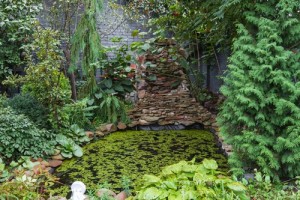How Irrigation Can Improve Your Lawn, Garden and Curb Appeal
The reasons that homeowners and businesses have irrigation systems installed are easy to understand. They’re trying to eke out more bang for their buck by going with irrigation advancements like micro irrigation, drip irrigation and spray tanks.
Irrigation is simply the best way to ensure that your home garden and lawn care needs are being met without having to worry about underwatering or overwatering.
Because irrigation and home sprinkler systems can be automated, you don’t need to fuss about achieving the best results possible.
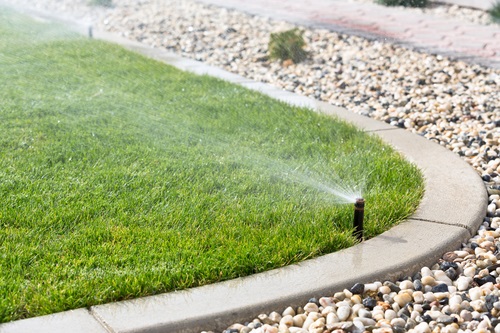
Irrigation Benefits Your Entire Property
You can even automate your system to behave differently in your garden versus your lawn, and you can also change up your watering cycles based on seasonal changes or plant growth.
Drip irrigation systems can also be extended to reach places that are just growing in or ones that didn’t exist when you originally installed the system. In terms of modifiability and adaptability to changing conditions, that’s pretty much the gold standard.
Especially when you’re dealing with a larger lawn in an arid region or a larger commercial property that needs virtually around-the-clock attention, an automated sprinkler system coupled perhaps with a drip irrigation setup can actually save you money long term. Homes benefit and conserving water, money and manpower is what it’s all about.
- Save Water, Conserve Manpower, Increase Curb Appeal
Drip irrigation is especially advantageous to homeowners and businesses in arid regions of the country that seasonally experience droughts, water shortages and steeper water prices (e.g., states like California).
The way that drip irrigation works – allowing water to drip down to different plants and root zones via pipes, emitters and valves – can consistently deliver more water to the roots and increase yields….all while saving water.
At the same time that you’re saving 50% more water compared to regular sprinkler systems, you’re getting better coverage and you’ll naturally experience less weed growth.
All of this together could very well bolster your curb appeal or, if you’re running a business, bring in more customers: A professional first impression goes a long way.
Incorporating Irrigation Into Your Lawn Care Routine
Business owners reading this might be scratching their chins and wondering whether they really need an irrigation system or if they can get by with simply watering twice a week. First off, you should realize that simply watering might not be enough.
If you’re running a commercial property, then irrigation is but one piece of the puzzle when it comes to maintaining a professional image. Mowing, mulching, fertilization, aeration and leaf removal might all be part of the overall picture in terms of getting the most out of your property or maximizing the curb appeal of your home.
That said, irrigation is one of those foundational lawn care services that really gets at the heart of landscaping. Why? Because irrigation delivers water right to the root source and if plants, trees and lawns don’t have enough water and sunlight they’ll definitely under-perform.
- Easy (and Expandable) Installation
While soaker hoses and sprinkler hoses might be the easiest-to-install and most DIY form of drip irrigation around, even professionally installed drip irrigation systems are relatively simple to install and shouldn’t require any excavation at all.
Because residential and commercial irrigation systems frequently rely on tubing, you can work with a landscape maintenance company to home in on the best location for the system. You can even move the system around if your needs change or power up/down the system to fit seasonal changes.
Drip irrigation systems efficiently deliver water right to the root source and are ideal for cost-efficiently achieving the best lawn possible. Consult with us on how you can benefit.
6 Xeriscape Ideas
Xeriscape gardens are specially built to require little to no irrigation. Instead, they’re specially constructed to use minimal water, and conserve the natural water (like rainwater) that enters their system. The end result is an environmentally-friendly garden that’s still beautiful.
Because xeriscape involves such skill and knowledge, it can be tricky to know where to get started. But with these six xeriscape ideas, you’ll get a head start on planning your garden.
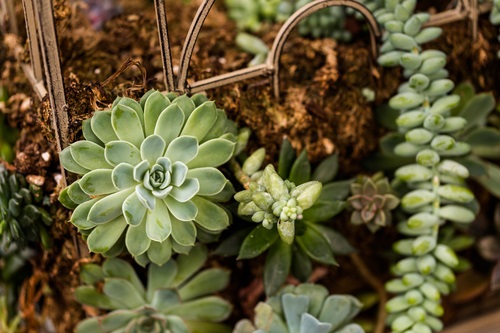
1. Think Beyond Cactus
Many people think xeriscape gardens are restricted to cactus and succulents. But most local plants are resistant to dry conditions in your area. Research native plants, or inquire with local gardening organizations, to find out what plants would flourish in your xeriscape garden.
2. Use Drip Irrigation
While many xeriscape gardens use no irrigation whatsoever, some use a form of irrigation called drip irrigation. Put small holes in a garden hose (or buy a hose specially perforated for this purpose), then lay it flat against the ground or near to it. Run this hose in the early morning or late evening, to minimize water loss due to heat.
The vast majority of the water through this slow drip system will get soaked up through the earth where it can nurture your plants, rather than getting lost to spray or evaporation. This is a good way to keep even drought-resistant plants through dangerous droughts, or to encourage your blooms to look their fullest during a dry season. To further maximize this method’s potential, place any plants that need more water close together, so they’re easier to water.
3. Try Perennials
Perennial flowers are more likely to be drought-resistant than annuals, and they’re lower maintenance, too. Try planting a group of perennial blooms close together to maximize their visual impact. For additional beauty, choose several perennials that will bloom at different times of year and plant them throughout your garden, to make sure you’ll always have something blooming.
4. Plan for Fall and Winter
Plants like Russian sage and many ornamental grasses dry out in the colder months. This is actually a positive: a well-planted standing will look like a dried bouquet. Add these to your xeriscape garden so there’s always something to draw the eye, no matter the season. You may even choose to avoid cutting back plants in colder months, to better take advantage of dried plants’ unusual shapes and appearances.
5. Fill Space with Rocks
Many xeriscape gardens gravitate toward gravel for open spaces. Gravel is great because it isn’t water-hungry like grass, and it holds moisture better than soil. But adding some beautiful rocks to cover space is a way to add texture and color to an area. Even just a small portion of rock garden adds character and variety to your xeriscape garden.
6. Play with Style
Not every xeriscape garden needs to look like a desert. With a little creativity and planning, xeriscape adapts well to any aesthetic or garden style. Don’t be afraid to think outside the box.
Xeriscape isn’t just environmentally friendly: it encourages creativity by imposing limits and forcing gardeners to think outside of comfortable tropes. Contact us and let us, plan and think creatively together. You’ll create a water-efficient space that’ll look its best in any season.
Use a Weed Eater and Get Rid of Pesky Shrubbery
If your property is saddled with unsightly shrubs that just keep getting in the way of the rest of your landscaping or even your walkways, the solution is our weed eater service. Shrubbery has a tendency to overgrow in every which way, causing all sorts of havoc. This is a common problem that can be cleared up by our weed maintenance team.
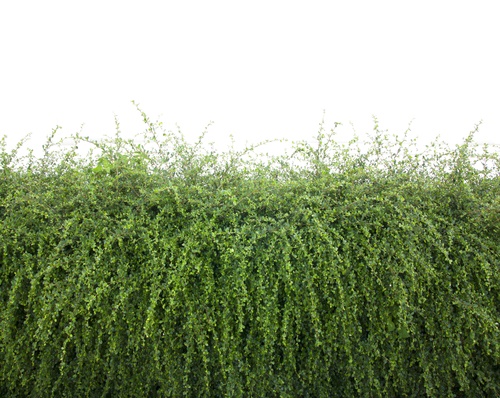
Do Yourself a Favor and Ally With the Weed Control Experts
Unruly shrubbery has the potential to ruin an otherwise beautiful yard. The weed control aficionados here at DK Landscaping know all the nuances about weed control products and weed control strategies. We will prevent wayward shrubs and weeds from overflowing onto surrounding components of your landscape. If you have any questions as to what the best way is to manage those pesky shrubs, do not hesitate to reach out to our experts. We know the ins and outs of weed control products as well as weed eating machines. Allying with our team has the potential to save you plenty of time, money and heartache.
Don’t Torture Yourself Attempting to Manage Shrubs by Hand
DK Landscaping has all the equipment that is necessary to get rid of those unruly shrubs once and for all. Too many homeowners make the mistake of trying to manage shrubs and weeds by hand. This is a waste of time and effort. You can trust our team to use our state of the art weed eaters to put an end to your shrub problem. It is a quite an easy solution compared to attempting to find a product that will keep those shrubs under control or using your hands to remedy the issue.
Our Weed Eater Equipment
DK Landscaping refuses to use anything but the highest quality metal blade edgers to trim shrubs and other aspects of customer lawns. This style of cut allows for superior precision and control to generate the cleanest possible cut. It is a stark contrast from our competitors who use string edgers that create wavy edges and ugly wide gaps. Such wavy edges and gaps look terrible and allow for conditions in which weeds and shrubs grow in all directions. You can rely on our shrubbery and weed experts to use our weed eaters with great care. Our team is well aware of the fact that these powerful machines move at speeds topping 4,000 revolutions per minute.
Shrub Beds are Quite Sensitive
There is absolutely no point in attempting a do it yourself (DIY) style shrub maintenance job in which you pluck shrubs/weeds out of the ground. Hand weeding actually leaves the roots intact so those annoying weeds and shrubs will keep on growing right back. Furthermore, using a low quality weed fabric will allow weeds to break through. Even attempting a DIY mulch job has the potential to exacerbate your shrub and weed problem. If you do not select the proper type of mulch, it will affect the soil’s warmth and consequently impact the growth rate of your shrubs.
DK Landscaping is Here to Help
You are not alone in your battle with these disorderly shrubs. When you ally with DK Landscaping to eliminate those pesky shrubs, you will no longer feel disappointed and annoyed when you look at your property’s landscaping. Our weed eaters will get right down to the core of the problem so you don’t have to invest one more second in shrub management. Reach out to DK Landscaping today to schedule a consultation and/or an appointment. We’ll discuss our services in-depth with you and provide a quote. Contact us today by dialing 707-280-3632.
About Watering Lawn After Mowing
Engaging in watering lawn? As the weather heats up, more people will be venturing out into their yards to mow, plant, trim, and generally get things spruced up. Mowing the lawn becomes an almost constant chore from the time the dandelions pop up in the spring until the leaves fall in the autumn. Whether you choose to mow your own lawn or hire experienced professionals, you may have some questions about watering your lawn after mowing.
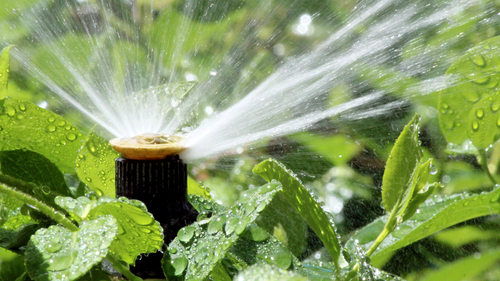
Setting a Schedule for Mowing
While mowing and watering are two separate chores which should both be scheduled, it’s important to leave room for flexibility for the days of drought and when it pours. The lawn needs mowing when the grass reaches a certain height and watering when the grass is dry. Those two events may or may not occur at the same time. Establishing a schedule to address these needs will help you make sure you aren’t wasting water or time. You should mow when grass reaches a height of about 3 to 4.5 inches. When it’s tall enough, trim it to about 2 to 3 inches. Depending on the season and type of grass, you may need to schedule mowing as often as every 5 days.
Setting a Schedule for Watering
Schedule your watering so that grass gets about 1.5 inches of water per week during the growing season. Time of day is also important to consider. Morning is an ideal time to water because it allows the grass to soak up the water before the heat of the day. Watering in the middle of the day wastes water because the sun speeds evaporation. In addition, watering too late in the day leaves insufficient time for the water to soak in before it cools off at night, potentially leading to fungal growth or other disease.
Knowing When to Water by the Color of Your Grass
Determining that grass needs water is a little tricky, but there are some things to look for. Grass that fades from bright green to a dull, bluish gray is probably thirsty. Also, look for signs of wilting, such as curling grass blades. Another trick is to look for footprints in the grass after you’ve been walking in the yard. Hydrated grass will spring back more than dried grass so, if you can see that you’ve left a trail, it’s time to water. One foolproof way to know if your grass needs a drink is to use a simple moisture meter, available at many garden stores. Or, utilize a rain gauge so that you know how much natural precipitation has fallen during the week.
A Pristine Lawn Takes Time and Attention
So, should you water after mowing? The simple answer is yes, but only if your grass needs the moisture. If you’ve had a rainy week and the grass isn’t showing footprints or other signs of dehydration, you can probably put off watering for a bit longer. If your lawn does need to be mowed and watered, make sure you schedule it for early in the day to avoid moisture evaporation and problems with disease. Don’t water your grass before mowing. Wet grass tends to clump together on the lawn which could suffocate the grass underneath or promote fungal growth. Also, it could clog up your mower.
Mowing is an essential aspect of home maintenance. A freshly-mowed lawn looks great, feels wonderful on bare feet, and helps keep invasive weeds in control. To handle all of your mowing needs, get in touch with the professionals at DK Landscaping today. You can trust us to keep your yard looking great for all seasons.
Narrow Walkway Flower Bed Ideas
Flower bed ideas can be quite easy to implement. Most gardens have walkways that are about two feet wide. Narrower walkways may help you to use a small space more efficiently.
However, they pose a unique design challenge to gardeners, landscapers and homeowners: how can you create and position flower beds so that they don’t visually overpower the walkways? Try these flower bed ideas to add variety and beauty to your space.

Perennial and Evergreen Flower Bed Ideas
Narrow walkways limit access to your flower beds, and make maneuvering through the space more difficult. Annual plants are flower bed ideas that can create headaches due to yearly replanting. By choosing perennials suitable to your climate, you’ll ensure that your plants come back each year and minimize the amount of work you (or your landscapers) must do.
You may also put evergreen plants on your list of flower bed ideas. These come back each year, and the plants won’t lose their leaves or fade in ways that require additional maintenance.
Keep Flower Beds Controlled
If your flower beds grow weedy or otherwise out of control, they can cut into your walkway. Normally that may be unsightly, but not a disaster. But if your garden’s walkways are narrow, this can make the pathway difficult to navigate, or even find. This is particularly problematic with gravel or dirt walkways, where the edges are already, often, poorly defined.
When going through your flower bed ideas, make sure that the line between the flower bed and the path is clearly marked. You may want a small fence, stone wall or other raised marker. Make sure your flowers are semi-regularly pruned back from the edges of the path, and that any weeds are removed. You may want to choose plants that grow more slowly, and that put off fewer vines or shoots for you to have to deal with.
Use Trellises
Trellises and fences are perfect flower bed ideas for climbing plants, that allow you more room to play. Be sure to choose climbing plants that don’t grow to too tall of a height, to minimize maintenance. Many vines are invasive, as well, so be sure that your final choice is native to your area.
Create a Unique Environment
Finally, once your flower beds are complete, your garden may feel crowded. Take advantage of this by creating a unique atmosphere. Delicate lighting along the edges of your path, or hanging from trees, can create a mysterious atmosphere like an enchanted forest. A little fence around the whole space, along with a gate, is one of those flower bed ideas that can make your garden feel like something out of a fairy tale.
Conclusion
When you want to implement your flower bed ideas, it’s time to call an expert. Contact us for a consultation about your yard and its specific needs, including repair, maintenance, irritation, and xeriscaping for saving water.
Inexpensive & Easy Backyard Ideas
Spring is just around the corner, and what better time than now to give your backyard a makeover? Whether you have a cozy yard or a sprawling retreat, there are a host of inexpensive and easy backyard ideas you can try that will enhance your lawn, garden and outdoor living areas.
Easy Backyard Ideas
- Create a living fence by decorating a wall with an espaliered tree. You don’t have to be a master gardener to do it, and it gives your yard a high-end look without the high-end expense. Espaliered trees are a great way to make a small yard look like it’s filled with greenery.
- Here’s one of the best money-saving backyard ideas. For an inexpensive way to add hardscaping – walkways, edging and retaining walls – ask your landscaping company if they have stone leftovers. Stacked together, the different shapes, sizes and colors make a beautiful elevated garden section that looks incredibly natural. Use low-growing groundcovers and other perennials to present a gorgeous burst of color.
- Sometimes, the simpler the better backyard ideas win the day. Create low-cost nooks by rearranging garden furniture in separate areas of the yard; perhaps one area for eating and another for relaxing. The idea is to create conversation zones where family and guests can gather to catch up and enjoy themselves. No need to buy new furniture – but coordinated pillows and chair pads are great for giving each area its own distinct look.

- One of the easiest backyard ideas for adding color is by using containers that are filled with annuals. Annuals are less expensive than perennials and shrubs but really pack a punch when arranged in containers. For a calm, retreat-like feel, use vessels of one color, though the shapes and sizes can differ.
- If you’re in need of a new piece of furniture, but it’s just not in the budget this year, try this fun DIY seating area constructed from low-cost concrete blocks that are fitted with wood beams and then a foam cushion. True sophistication for little money!
- Outdoor lights are one of everyone’s favorite backyard ideas. They’re fun, they say celebration and their sparkle adds a warm glow to backyard gatherings. Use different color string lights or LED cords to wrap a tree or line a pathway. You can even run a set down the length of the table for a lovely light to dine by.
- If you want to cut back on how much water-hungry lawn you have, check out interesting, less-expensive paving materials such as crushed rock and gravel. They’re perfect for placing underfoot at outdoor seating and dining areas. If you’re in love with the look of traditional, larger pavers, use fewer of them interspersed in your grass in order to cut down on your total outlay.
- Many hardscape elements, such as trellises, can be found at flea markets or garage sales. You may even have enough scrap materials around the house to construct one. Who doesn’t have a bunch of old frames packed in boxes just waiting to be used “one day?” Take some inspiration from this beautiful piece and put those frames to good use. If you love the rustic look, there’s no need to varnish or paint them. Trellis are one of the best backyard ideas for adding height and defining backyard traffic flow.
There’s always a way to get the beautiful backyard you’ve always wanted without having to break the bank. These fun and beautiful backyard ideas are the perfect way to get started!
Layouts and Landscaping Small Backyards
They may be diminutive in size, but small backyards can be designed and landscaped in much the same way as their larger counterparts. From a quaint cottage-style yard to a modern, minimalist look, landscaping small backyards works best when you remember to design in square inches, not feet. In addition to this also use imaginative techniques such as creating multiple focal points, and use a varied selection of plants and shrubs. While backyards with limited space present a challenge, there’s nothing to prevent you from creating a cozy and charming retreat that can also work for family entertaining. To design a truly outstanding small backyard, follow these basic design and layout principles.
Inches, Not Feet
While most landscaping is planned out by the square foot, backyards with small footprints should be designed utilizing square inches, because fitting the amenities and plants you want in a tiny space requires a very precise layout. A mere two inches can make or break your opportunity to expand a raised planter wall to seat wall width; and just a six-inch difference here or there will determine whether you can have features such as ponds, fountains or fire pits.
Use Multiple Focal Points
Probably the biggest design challenge with small backyards is the lack of space to create that one standout focal point you often find in larger backyards. The solution, then, is to create many smaller, surprising focal points throughout your yard. Stone, ceramic, glass or metal accent pieces -new or vintage – can be arranged in such a way that they create an element of delight when discovered. For a distinct look, stay away from mass-produced items and make your small backyard uniquely yours by searching for one-of-a-kind pieces of garden art. For maximum effect, place your garden art amidst your plants, so they look as though they’ve always been there.
Don’t Stop at Green
Place bold and bright plants and flowers at the front of your small landscape so that they are the first thing to catch the eye upon entering the yard. They’ll also make the rest of the backyard recede, resulting in a larger feel to the space. Use plants with lots of texture, and try putting in a few large-leaf plants – they work wonders at changing the scale of small backyards.
Create Small Discrete Zones
As counterintuitive as it may sound, dividing a small space can actually make it seem larger. Try a tall hedge, fence, wall, or shrub to create a partition. Place furniture groupings and paths so that several small attractive and restful “rooms” are created.
Xeriscape Ideas for Small Backyards
Xeriscaping is one of the most popular landscaping options today, particularly in California, as it requires a minimal amount of water. In addition to reducing the need for supplemental irrigation, drought-tolerant landscaping can also be visually more interesting than other landscape options, and it will save you money. Xeriscape landscapes require very little turf, include plants that can withstand harsh elements and embrace designs that make small backyard landscapes really stand out:
- Use stepping stones and gravel to create a path and then fill in the side areas with native grasses.
- If you have stairs up to a deck or patio, fill them with gravel and native plants to add an unexpected touch.
- Choose low maintenance greenery that will thrive in your zone and don’t forget to opt for some colorful choices – the results can be stunning.
Bringing big design to small backyards is a great way to create a space for family and friends to dine and play. So contact us for consultation. Don’t be surprised if it becomes everyone’s favorite place to gather!
Garden Design for Dry Shady Gardens
When you’re looking to improve the landscape around your home or business, dry areas with shade can be tricky when it comes to garden design. Luckily the modern practice of xeriscaping has provided many solutions that can be used to get a beautifully landscaped property even when planting in dry shade.
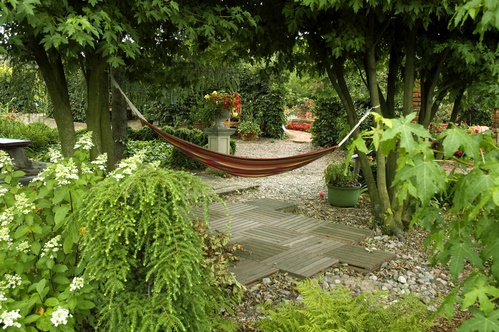
Basic Garden Design Principles
Any of the basics of good garden design apply to dry shady areas as well. You will want to think about how the area is going to be used, whether you prefer a casual or more formal style, and what your budget will be.
You will want to consider the size and shape of the plants and the visual lines they create. It can be helpful to start with the larger elements or focal points of your design, and then fill in the smaller details from there. Variety is necessary to create visual interest, but too many different colors, textures and plant species can create a chaotic look that lacks cohesive design. A common element such as a particular species of plant or a recurring color can help tie different areas together into an overall design.
For a successful dry shade garden design considering the water supply is vital. This is where consulting a landscape professional can be especially helpful. They will have ideas for making the best use of naturally available water. They may recommend grading an adjacent area to improve drainage, diverting extra water to a drier area. Including rain water harvesting in your garden design or changing irrigation methods may also be options.
The Importance of Plant Selection in Dry Shade Garden Design
One of the biggest decisions in garden design is choosing plants. You can get a garden design that is practical, unique and aesthetically pleasing, even in dry shade. It may limit your options a little more than having perfect growing conditions, but there are still plenty of plants to choose from. Skeptical? Check out this large list of plants for dry shade or this amazing list of native California drought tolerant plants. Many of these species grow just fine in shade. The growing popularity of xeriscaping means there are more plants available to homeowners and landscape professionals that tolerate dry conditions. Native plants will also grow better in dry shade since they are already adapted to local conditions.
One of the most useful garden design practices for dry shade is grouping together plants with similar water and nutrient requirements. Plants will not have to compete with each other to get what they need and will be more likely to thrive. Reducing the amount of turf lawn in a dry shady area or using grass varieties that require less water can also be helpful.
Soil Preparation is Key
When it comes time to make your new garden design a reality, soil preparation is especially important. The water and nutrient requirements of the new plants and condition of your existing soil will determine your exact course of action. In general, adding organic matter such as compost may be necessary. This will help your dry soil retain water and increase the nutrients available so your plants can thrive. Mulch also serves the same purpose and additionally deters weeds. Using these together will give your new plants the best chance to establish a good root system and promote growth.
While there are lot of things to consider in good garden design, the effort can save property owners money in the long run by reducing fertilizers, water, and maintenance. Get help with your landscape design and maintenance needs. Contact us today!
7 Gorgeous Flowering Shrubs for Shade
A shady yard doesn’t have to stop you from having a gorgeous, lively landscape. Flowering shrubs that thrive without direct sun are a perfect choice for jazzing up your landscape, and there are many varieties to choose from. Here are our top 7 choices for flowering shrubs that work well in Zone 9:
Oakleaf Hydrangea (Hydrangea quercifolia species)
With its spikes of beautiful white flowers and distinctive oak tree-shaped leaves, this shrub attains an impressive height and width of six to 10 feet and is partial to moderate shade. In late summer, its blooms change to a pinkish purple, and come fall, the leaves take center stage and put on an impressive show of orange-red, purple and brown, which lasts well into winter.
Rhododendron (Rhododendron species)
A shrub with its own fan club, there are more than 900 species of the Rhododendron. Most grow to a height and width of eight to 10 feet, bloom in late spring, and then present attractive foliage after that. This is the shrub to choose if you’re looking for colorful shade flowers – and with all the different varieties on the market you’ll have no problem finding your favorite color.
Serviceberry (Amelanchier species)
Another shrub with multiple varieties to choose from, you’re sure to find one that meets your yard’s aesthetic needs. The company running serviceberry is a compact four to six-foot shrub that’s perfect for smaller landscape layouts. A year-round winner, blooms debut in the spring and edible berries make a June appearance. Those who love low maintenance shrubs will love that it requires little pruning.

Japanese Kerria (Kerria Japonica species)
Slow to start but followed by rapid growth, this three to six-foot shrub is the one to choose for year-round color. Bright green leaves that appear in summer last through most of the fall, when attractive yellowish green or bright green stems appear to brighten up your winter landscape. Gorgeous, bright yellow blooms make a spring appearance.
Virginia Sweetspire (Itea Virginica species)
With vivid red leaves that last well into the fall, these four to five-foot shrubs burst with fragrant summer flowers and are extremely resistant to disease or insect problems. The Little Henry is a popular choice that gives better-known shrubs such as the burning bush a run for their money.
Red Chokeberry (Aronia Arbutifolia species)
Stunning crimson leaves in the fall and bountiful red berries that brighten up even the drabbest of winters, these shrubs grow from six to 10 feet high. The red chokeberry is a resilient shrub that does well even in poor soil, and it tolerates both wet and dry conditions. Glossy summer foliage complements the small white or red-tinged blooms that make their appearance in the spring.
Sweetshrub (Calycanthus floridus)
A versatile classic, this moderate-shade shrub continues to gain popularity due to its xeriscaping properties. It works well in dry to damp soil and grows from four to six feet tall. The sweetshrub’s maroon flowers bloom from spring to summer and are often highly fragrant; the leaves on these shrubs have a coarse texture. If you have a yard that sees frequent visits from deer, this is the shrub for you.
Finding just the right shrubs to plant in the shady areas of your landscape may seem like a challenge, but as these selections show, there are plenty of varieties to choose from. Whether you choose one particular species as a show-stopping focal point or mix and match several kinds, these recommended shrubs should bring some beautiful color and life to even the most sun-deprived areas of your yard. Contact us for consultation on your gardening project.
Planning and Maintaining a Shrubbery
Rock gardens and shrubberies might be the two best ways to add dimension to your landscaping efforts without breaking the bank or giving yourself more work down the road. Just like a rock garden, shrubberies are coming back in style!
Shrubberies are actually easy to maintain and take care of as well. Shrubs are technically woody plants that are far shorter than most trees yet have a network of stems that can really liven up a backyard or add a little privacy to your home’s front facade.
Flowering broom shrubs and rhododendrons even look beautiful in their own right and don’t need too much support from your annuals and perennials to enliven your home.
That said, a lush lawn never hurts, so if you need help in that department DK Landscaping is here to lend a helping hand. DK Landscaping can also help with irrigation.
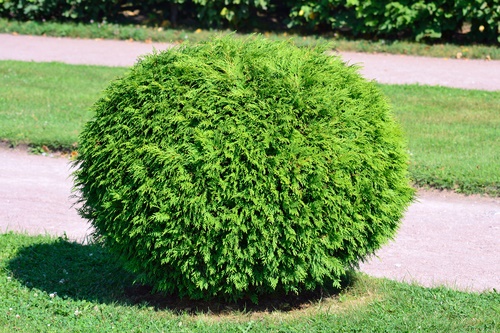
Planting a Shrubbery on Your Property
Shrubs are normally under ten feet in height and can either be evergreen or deciduous. This means that you can expect to find two classes of shrubs – one of which loses its leaves every autumn and then grows them back come springtime (deciduous) and the other kind of shrub retains its leaves on a year-round basis (evergreen).
- Leaving Room to Grow
Two other factors that you need to consider right off the bat is the maturity of the shrub that you’re interested in and, secondly, making sure that that shrub has enough room to grow without crowding out its neighbors.
The maturity and species of the shrub you go with will go a long way in determining how much space you need between each shrub and whether you’re letting in too much (or too little) sun to all of the shrubs you’ve planted as they go along in their growing cycle.
As an example, a shrub that’s much more bush-like and grows vertically like a arborvitae will require less sun, root space, and maintenance since it’s an evergreen and its stems don’t tend to blossom horizontally.
Bamboo palm or barberry, on the other hand, are actually quite low to the ground and need a little room to blossom out horizontally, so you’ll want to leave adequate space between each one and enough daylight so that the sun can reach down and nourish each individual shrub.
- Dig a Wide Hole
After you’ve picked out which shrub goes with the surrounding flowers and accessories in your yard, you need to transplant your shrubs and get them into the ground safely.
Digging a hole double the width of your shrub’s root ball is a good way to ensure that the roots get nourishment. After you’ve dug your hole then make sure to jostle the soil around slightly so that you’re not dealing with packed soil and your shrubs can continue to get nourishment.
- Transplanting the Shrub
When your hole is dug, carefully lower the shrub into place and put soil around the base. Then you’re going to want to spread out some mulch at the shrub’s base – just make sure that you go no more than six inches deep with your mulch.
- Regular Maintenance and Watering
Shrubs grow best in moist conditions that avoid too much saturation.
This means that regular watering from March to August in four-season climates should, in conjunction with some help from the sun and mother nature, provide most of the nourishment that your leucadendrons, rhododendrons, buckthorns and butterfly roses need to flourish.
An irrigation system is one of the best ways to prevent water waste and over-watering. For more on shrub maintenance and irrigation, contact DK Landscaping’s specialists today.


